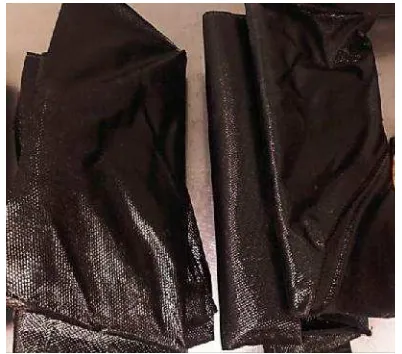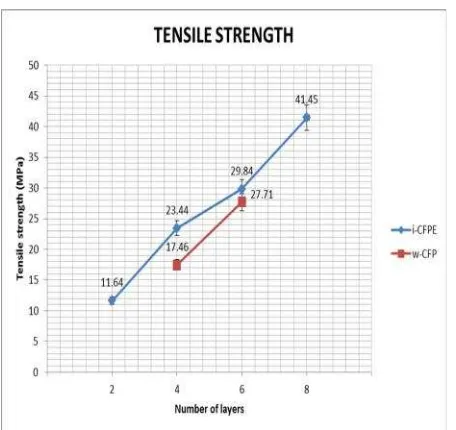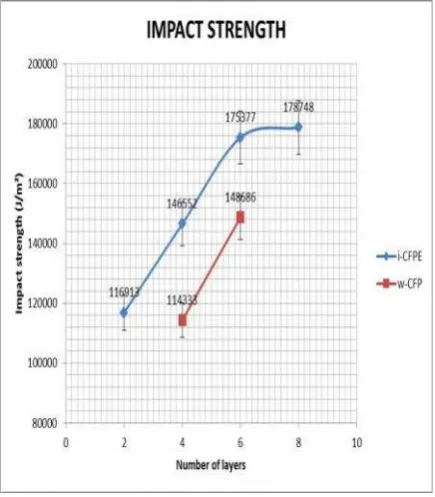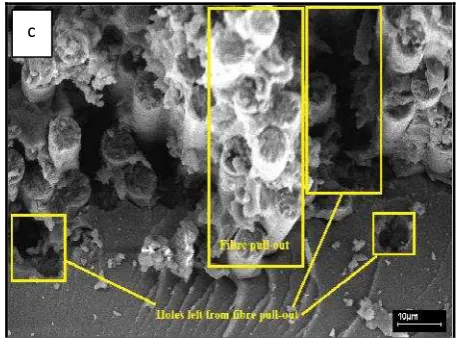Preliminary study of CFRP
manufacturing offcuts with
secondary resin impregnation
via hand lay up
Hairul Effendy Ab Maulod
1, a,
Juliana Yaakub
2, b, Mohd Yuhazri
Yaakub
2, c, Abdul Rahim
Samsudin
3, d, Noraiham Mohamad
2, e1
Department of Manufacturing Engineering Technology, Faculty of Engineering Technology, Universiti Teknikal Malaysia
Melaka, Hang Tuah Jaya, 76100 Durian Tunggal, Melaka, MALAYSIA
2
Department of Engineering Materials, Faculty of Manufacturing Engineering, Universiti Teknikal Malaysia Melaka, Hang Tuah Jaya, 76100 Durian Tunggal, Melaka,
MALAYSIA
3
Department of Manufacturing Design, Faculty of Manufacturing Engineering, Universiti Teknikal Malaysia Melaka, Hang Tuah Jaya, 76100 Durian Tunggal, Melaka,
MALAYSIA
Keywords:composite recycling, CFRP,
Abstract. Carbon fibre reinforced polymer (CFRP) composites have been extensively used because of their excellent performance and lightweight. Due to its widespread use, manufacturing scrap and end-of-life prepregs is constantly generated. Investigation into the potential of CFRP reclamation by second impregnation process via hand lay-up was performed. Focusing on the effects of number of layers (2, 4, 6 and 8 layers), to the physical and mechanical properties of laminated secondary impregnated Carbon Fibre Prepreg Epoxy (i-CFPE) composites. It was then compared with laminated Carbon Fibre Prepreg composites without second impregnation (w-CFP). Samples were tested under tension, flexural and impact.
Mechanical properties of i-CFPE increased with the increase of laminates layer in the composites. Furthermore, i-CFPE laminated composites showed better performances if compared to the w-CFP.
Introduction.Carbon fibre has seen exponential growth in usage in a wide array of application. With the advent of regulatory directives such as The End-of-Life Vehicle Directive (Directive 2000/53/EC) and EU Directive on Landfill of Waste (Directive 99/31/EC), proper waste management of carbon fibre are currently being studied extensively.[1]
A more economical approach of recycling CFRP is to through mechanical recycling such as cutting and shredding CFRP and using it as reinforcements or fillers for later applications[2, 3]. The challenge of using the CFRP wastes for other value added applications worthy of its own expensive source value are now leading researchers for carbon fibre extraction[4, 5].
Carbon fibres could come from various sources. Whether cured on uncured, the aim of recent studies is to extract as pure as possible the carbon fibres [1, 6, 7]. Removing unwanted fillers, reinforcements and additives could in future promise a whole new range as well as reinforcing current applications for recycled carbon fibres.
This paper introduces initial results of recycling manufacturing offcuts of carbon fibre prepregs from a local composite manufacturing company by hand lay up with epoxy resin and its mechanical properties.
Methodology. Manufacturing offcuts of carbon fibre prepregs were collected from a local composite manufacturing company and still had up to 90 hours of preimpregnated resin outlife as in Figure 1. The company’s name and trade name of the carbon fibre prepregs could not be disclosed due to sensitivity of its operations and the material’s export license.
manufacturing offcuts, 20 sheets were reserved to be laid up with commercially available epoxy resin while 10 sheets were hot pressed without adding any resin. The first 20 sheets were sorted for 2, 4, 6 and 8 layers and later hand lay up with epoxy resin. Vacuum bagging was later applied on different layers to ensure removal of entrapped air and removing excess resin. The second 10 sheets were sorted into 4 and 6 layers, later hot pressed using a Gotech (GT 7014-A) compression moulding machine for 5 minutes at 180C.
Figure 1Carbon Fibre Prepreg Manufacturing Offcuts
Tensile test. Tensile testing was performed in accordance with the ASTM D3039, with 6 samples for each set of layered composites. For testing, a Universal Testing Machine with constant cross-speed of 2mm/min was used. The tensile strength, percent elongation and modulus of elasticity were calculated in accordance to ASTM D3039.
Flexural tests. Flexural testing were carried out in accordance to ASTM D790 (3-point loading) using six specimens (80 × 10 × 4 mm) for each set of layered composites. The tests were performed on the Universal Testing Machine at a constant cross-speed of 2.5 mm/min.
Water Absorption. Water absorption was done in accordance to ASTM D570-98. Samples for measuring water absorption were prepared in the form of bar with dimensions of 76.2mm x 25.4mm x thickness of layered
composites (W x L x t). The samples were immersed in distilled water maintained at a temperature in the container. The water absortion determination was based on Equation 1.3:
% wf = [(Ww - Wc) / Wc] x 100.
Morphology. Scanning electron microscope was done on each of the samples to study the morphology.
Results and Discussions. Tensile Test.
Figure 1: Tensile strength of i-CFPE and w-CFP laminated composite at different number
of layer.
Figure 2 show the flexural strength result for i-CFPE and w-CFP laminated composite. The flexural strength result of the i-CFPE laminated composite decreased with fibre contents and it was significantly higher than corresponding to without second impregnated carbon fibre prepreg obtained in experiment. This if of course due to increasing layer, stiffness of the samples increased but what interesting to note was that the difference of value between secondary impregnation i-CFPE with without secondary impregnation w-CFP. The same 2 layers of i-CFPE could only produce 119.83 MPa, only 42% of the corresponding 2 layers of w-CFP of 282.02 MPa. This is in agreement with literature [7, 8, 14]. Lowering the amount of resin and visible voids improves the flexural property [14].
Figure 2: Flexural Strength of i-CFPE and w-CFP at different number of layer.
The plot of charpy impact strength in Figure 3 for i-CFPE and w-CFP laminated composite had shown the increasing trend of impact strength with different number of layers. From the Table 1, the charpy impact strength was found be increasing with increasing number of layers. Fibres addition helps with impact energy absorption [15, 16].
Table 1: Charpy impact properties of i-CFPE and w-CFP laminated composite.
Number of layer Impact Strength, J/mm2
With Second impregnation
Carbon fibre/Epoxy
laminated composite
(i-CFPE)
2 layer 116913
4 layer 146552
6 layer 175377
8 layer 178748
Without Second impregnation
Carbon fibre/Epoxy
laminated composite
(w-CFP)
4 layer 114333
The fibres can also give rise to high strength due to following mechanisms of dissipation of energy. Fibres may pull out of the matrix and dissipate the energy by mechanical friction [15]. From the study, it clearly shows that the impact strength increase as fibre content increasing. This statement was strongly supported [17] which found that, the higher amount of fibre provides high adsorption surface energies for the formation of the spot of failure sites, which later requires comparatively less energy to initiate a crack.
Figure 3: Impact strength of i-CFPE and w-CFP at different number of layer.
Water absorption curve was illustrated in Figure 4 where the percentage of water absorption was plotted against time for all samples. The plotted graphs showed maximum amount of water absorption in the first day of exposure to the all samples. Then, it slightly decreased with time reaching a certain value at saturation point where no more water was absorbed and the composites water content remained constant. This may due to the ability of epoxy resin to limit the absorption of water flow into the carbon fibre/epoxy laminated composite (i-CFPE) since the epoxy resin matrix has a water-resistance nature. This is one of the reason epoxy resins are the most widely used resins in high performance composite structures
these days. According to Choi et al. (2000) [11], the absorbed water molecules in polymer composite materials are known to have significant effects on their physical and chemical properties of matrix as well as on their final performance of composite structures especially in their long term utilization.
Figure 4: Water absorption characteristic of i-CFPE and w-CFP at different number of layer
within 7 days of immersion.
The morphology of the i-CFPE and w-CFP laminated composite were observed under SEM to investigate the interfacial bonding and the interaction between the epoxy resins with the fibres. Micrographs in Figure 5 (a, b) showed comparison of the fractured surface of the i-CFPE and w-CFP laminated composite. From the figure, it clearly shows the i-CFPE surface was fully and better covered by epoxy resin which further indicates presence of strong interfacial adhesion and good wettability between the fibre and matrix compared to w-CFP. These interactions tend to lower the interfacial tension between the matrix and its fibres making i-CFPE more compatible.
Besides that, it can clearly be seen the morphology of the laminate composites of both has rough surface. This further proved the phenomena of brittle fracture of fibre and matrix. Thus the overall morphology for both i-CFPE and w-CFP sample indicates the brittle fracture behaviour.
Figure 5: SEM micrograph of fractured surface of the (a) 4 layer w-CFP and (b) 4 layer i-CFPE laminated composite sample indicating fibre and epoxy resin wettability.
It is generally agreed that the pull-out work of fibres or several cracks provides the main source of toughness or energy absorption capacity of carbon fibre laminate composites. The energy absorption capability of a composite is attributed to two basic mechanisms which material deformation and the formation of new surfaces by cracking. The material deformation occurs first. If the energy supplied is large enough, a crack may initiate and propagate, thus actuating the second energy-absorbing mechanism. Fibre pull-out and fibre breakage are example of this energy absorption mechanism. The fibre pull-out process involves, first, a debonding action which provides an alternative path for the crack to follow and second the formation of a new surface at the fibre-matrix interface. Moreover, the fibre deformation and compliance during pull-out contributes directly to the total deformation of the composite. These types of mechanism can be seen in Figure 6(a-c).
Figure 6: a) Fibres breakage and homogenous stage of fibre fracture.
Figure 6: b) Surface topography of a typical brittle composite fracture.
Figure 6: c) Fibres pull-out from the matrix presenting holes on the fracture surface.
CONCLUSIONS
In this study, mechanical properties particularly for tensile, flexural and impact a
)
b
Indication of good wettability between
matrix and fibre Indication of poor
wettability between matrix and fibre
a
.
)
b
.
)
c
.
properties of i-CFPE and w-CFP laminated composites are described. On the basis of the experimental evidence, the conclusions are as follows: tensile and impact test of laminated composites with second impregnation have showed improvement compared to without second impregnation. Both results favored an increased values as increasing number of layers and this behaviour is attributed to the compatabiliy of fibre-matrix bonding and interfacial anchorage. In flexural test, the results showed decreasing with increasing number of layers may due to weak bonding interface between the laminated composite plies and difficulty for the matrix to penetrate the hole of fibre when the fibre was almost cured. The percentage of water absorption was decreasing with increasing number of layers. According to scanning electron microscopy observation it is verified that presence of good wettability within carbon fibre and epoxy resin.
REFERENCES
[1] Pimenta, S. and S.T. Pinho,Recycling carbon fibre reinforced polymers for structural applications: Technology review and market outlook.Waste Management, 2011.31(2): p. 378-392. [2] Palmer, J., et al.,Successful closed-loop
recycling of thermoset composites.
Composites Part A: Applied Science and Manufacturing, 2009.40(4): p. 490-498. [3] Hidekazu Uno, T.O., Isamu Ohsawa,
Kiyoshi Uzawa, Jun Takahashi, Koji Yamaguchi, Akihiko Kitano,Mechanical Properties of CFRP After Repeating Recycling by Injection Molding Methodin
10th Japan International SAMPE
Symposium & Exhibition (JISSE-10)2007. [4] Jiang, G., et al.,Surface characterisation of carbon fibre recycled using fluidised bed.Applied Surface Science, 2008.
254(9): p. 2588-2593.
[5] Jiang, G., et al.,Characterisation of carbon fibres recycled from carbon fibre/epoxy resin composites using supercritical n-propanol.Composites Science and Technology, 2009.69(2): p. 192-198.
[6] Pickering, S.J., et al.,A fluidised-bed process for the recovery of glass fibres from scrap thermoset composites.
Composites Science and Technology, 2000.60(4): p. 509-523.
[7] Pickering, S.J.,Recycling technologies for thermoset composite materials--current status.Composites Part A: Applied Science and Manufacturing, 2006.37(8): p. 1206-1215.
[8] Pimenta, S., et al.,Mechanical analysis and toughening mechanisms of a multiphase recycled CFRP.Composites Science and Technology, 2010.70(12): p. 1713-1725.
[9] Buggy, M., L. Farragher, and W. Madden,
Recycling of composite materials.Journal of Materials Processing Technology, 1995.55(3-4): p. 448-456.
[10] Turner, T.A., S.J. Pickering, and N.A. Warrior,Development of recycled carbon fibre moulding compounds - Preparation of waste composites.Composites Part B: Engineering, 2011.42(3): p. 517-525. [11] Cunliffe, A.M. and P.T. Williams,
Characterisation of products from the recycling of glass fibre reinforced polyester waste by pyrolysis.Fuel, 2003.
82(18): p. 2223-2230.
[12] Jun Takahashi, N.M., Tetsuya Okazumi, Kiyoshi Uzawa, Isamu Ohsawa, Koji Yamaguchi, Akihiko Kitano,Mechanical Properties of Recycled CFRP by Injection Molding Method, in16th International Conference on Composite Materials2007. [13] Sebaibi, N., et al.,Mechanical properties
of concrete-reinforced fibres and powders with crushed thermoset composites: The influence of fibre/matrix interaction.
Construction and Building Materials, 2012.29(0): p. 332-338.
[14] Ryohei Fukui, T.O., Hiroaki Zushi, Isamu Osawa, Kiyoshi Uzawa, Jun Takahashi,
Recycle Of Carbon Fiber Reinforced Plastics For Automotive Application, in
9th Japan International SAMPE Symposium2005.
[15] Kim, J.-K. and M.-L. Sham,Impact and delamination failure of woven-fabric composites.Composites Science and Technology, 2000.60(5): p. 745-761. [16] Caprino, G., et al.,Irreversibly absorbed
impacted at low velocity.Composite Structures, 2011.93(11): p. 2853-2860. [17] Arib, R.M.N., et al.,Mechanical properties



